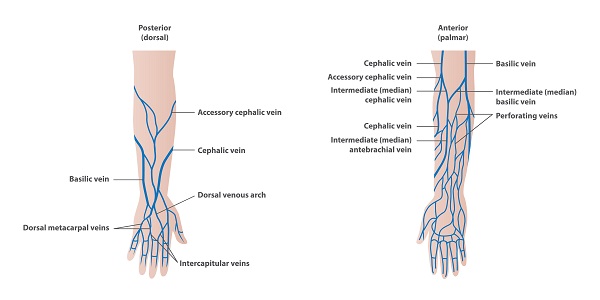

VENIPUNCTURE SITES DIAGRAM SKIN
The advantages at this site are that the skin is on 2-5 mm thick and the neck is relatively stable when the animal moves its head. Venipuncture should be accomplished readily immediately cranial to the site of compression using an 18 gauge, 1.5 inch needle directly craniad at the angle of 45° or less to the plane of the cervical skin. Vigorously stroke over the vein, cranial to the site of compression, to assist in its identification, which is assured by transmission of pressure waves to yout compressing thumb.

This process should be palpated with the thumb and then the thumb can be slid into a depression just medical to the process superficial to the jugular vein, where it courses between the sternocephalicus muscle and the ventral process of the vertebra. Palpating craniad from the point of the shoulder, the 2nd prominence felt will be the ventral process of the 5th cervical vertebra. the processes of the 5th and 6th cervical vertebra are most prominent. If blood for haemoglobin testing is gathered with a capillary stick, a single-use sterile lancet should be used and then placed immediately in a sharps container (safety box ).The second site is in the caudoventral portion of the neck where the ventral process of the cervical vertebrae can be palpated. Some bags include diversion pouches to sequester the first 20 ml of blood collected, to minimize contamination from skin flora and the skin core ( 52). –Ī closed collection system with a sterile blood collection bag containing anticoagulant, and with an integral tube and needle should be used. Fabric or textile carriers should be machine washable. Containers used to transport supplies and specimens should also be cleanable by disinfectants, such as sodium hypochlorite bleach solutions.

–įurniture and equipment in the area of blood donation and processing should be made of cleanable surfaces (e.g. Such equipment includes blood pressure monitors, scales, donor couches or chairs, blood collection monitors or mixers, blood bag tube sealers, blood transportation boxes and blood bank refrigerators. These pathogens include ( 2, 5, 12, 14, 17, 23, 31):Īll equipment used for collection of blood donations should be regularly calibrated, maintained and serviced, as required. Poor infection-control practices can lead to bacterial infection at the site where the needle was inserted into the skin ( 37).īoth patients and health workers can be exposed through phlebotomy to blood from other people, putting them at risk from bloodborne pathogens. The adverse events that have been best documented are in blood transfusion services, where poor venepuncture practice or anatomical abnormality has resulted in haematoma and injury to anatomical structures in the vicinity of the needle entry ( 35).Īnother issue for patients is that if a blood sample is poorly collected or destroyed during transportation, the results may be inaccurate and misleading to the clinician, or the patient may have to undergo the inconvenience of repeat testing ( 36). Unsafe phlebotomy can cause adverse effects for patients such effects are rare, but range from pain or bruising at the site of puncture, to fainting, nerve damage and haematoma.


 0 kommentar(er)
0 kommentar(er)
